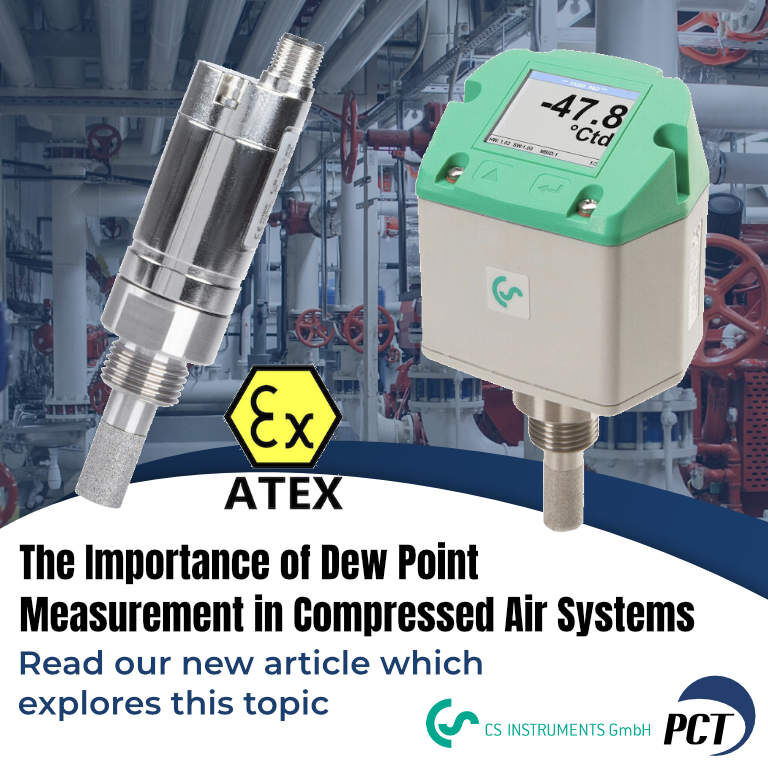
Monday, 11th December 2023
Ensuring optimal performance within a compressed air system is vital for efficient operation as well as a good return on your investment. One often-overlooked factor that significantly impacts system efficiency is dew point. Understanding and measuring the dew point is crucial for maintaining the integrity of compressed air and preventing issues that may arise from excess moisture. Here we discuss the importance of dew point measurement and explore the differences between two common types of dryers: refrigeration dryers and absorption dryers.
The dew point is the temperature at which air becomes saturated with moisture, leading to condensation. In a compressed air system, excessive moisture may result in corrosion, damage to your pneumatic equipment or pipework and compromised product / air quality. By measuring the dew point, plant managers can gain insights into the moisture content within the system, allowing for precise control and prevention of potential issues.
One of the main reasons to measure the dew point in a compressed air system is to prevent corrosion and damage to equipment. Moisture-laden air can lead to the formation of rust within pipes and tanks, compromising the structural integrity of the system. Additionally, water accumulation in pneumatic tools and machinery can cause malfunctions, leading to costly repairs and downtime. Regular dew point measurements enable proactive maintenance, ensuring that moisture levels are within acceptable limits.
In industries or processes where compressed air comes into direct contact with a product or process, maintaining a dew point is crucial for ensuring product quality. Excess moisture in compressed air can lead to defects in manufacturing processes or repeatability, especially in applications like food and pharmaceutical production. By monitoring and controlling the dew point, businesses can uphold quality standards, reduce waste, and enhance overall operational efficiency.
Refrigeration dryers are a common and effective solution for removing moisture from compressed air. They are often more energy efficient that other forms of dryers and typically are more cost effective to procure and require lower maintenance than other technologies. Refrigeration dryers operate by cooling the air to condense and remove water vapor. The cooled air is then reheated before entering the compressed air system. Refrigeration dryers are effective in achieving dew points as low as 2°C making them suitable for many industrial applications.
Absorption dryers are an excellent alternative when a lower dew point is required, typically down to -40°C to -70°C. Absorption dryers use a desiccant material to absorb moisture from compressed air. These dryers are capable of achieving extremely low dew points, making them ideal for applications that require ultra-dry air, such as in laboratories or certain manufacturing processes. Absorption dryers offer precise control over moisture levels and are often the preferred choice in environments where maintaining low humidity is critical.
CS Instruments range of Dew point sensors maybe used with both refrigeration and absorption driers with sensors which are capable of accurate measurement at -80°C.
Sensors and their electronics are able to output many vital datasets from your compressed air including:
Dew Point Sensors have Modbus RTU comms with optional Ethernet connectivity as well as the M-Bus protocol. Here are some of our popular products we offer:
To conclude, measuring the dew point in a compressed air system is a fundamental practice for ensuring operational efficiency and preventing moisture-related issues. The choice between refrigeration dryers and absorption dryers depends on the specific needs of the process.
By understanding the importance of dew point measurement and selecting the right dryer for the job, businesses can enhance the reliability and longevity of their compressed air systems. Regular maintenance, coupled with accurate dew point monitoring, is the key to unlocking the full potential of compressed air technology in various industrial sectors.
The unknown costs of your compressed air
Our team of expert engineers would be more than happy to answer any questions/enquiries you may have about your compressed air system and dew point - do contact us and we'll do our best to help.
PCT are a leading UK distributor and your enquiry will be handled with the utmost professionalism. Please provide your details below.